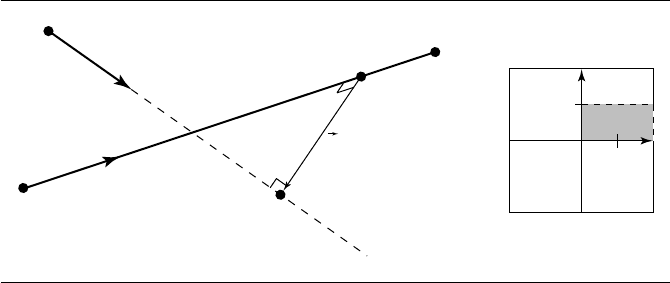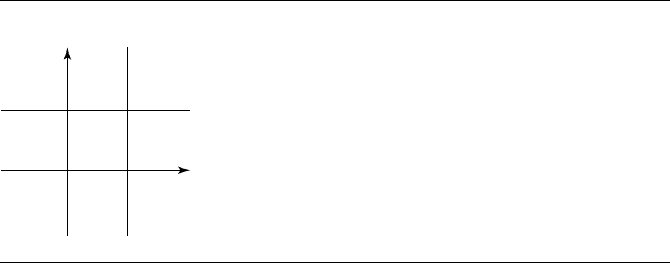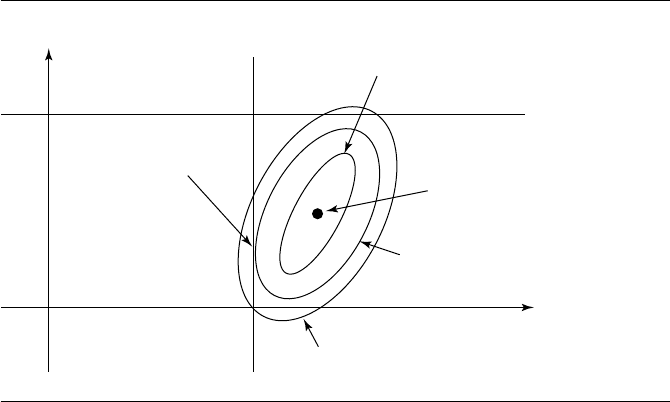Schneider P., Eberly D.H. Geometric Tools for Computer Graphics
Подождите немного. Документ загружается.


424 Chapter 10 Distance in 3D
1
1
s
t
P
1
P
0
d
1
ˆ
d
0
ˆ
Q
0
Q
1
v
Figure 10.35 Distance between a ray and a line segment.
RaytoSegment
Figure 10.35 shows two line segments we want to find the distance between, and
the restricted domain for the solution. In the case of a ray/segment distance test,
the domain of the distance function is [0, ∞] × [0, 1] (or vice versa); the domain
is bounded on three sides: either s =0, s =1, and t = 0, or t = 0, t = 1, and s = 0.
If the parameter of the closest point on the ray’s infinite line is less than 0, or if the
parameter of the closest point on the segment’s infinite line is less than 0 or greater
than 1, then we need to compute the nearest point on at most two of those edges.
The pseudocode is
float RaySegmentDistance3D(Ray ray, Segment seg)
{
u = ray.base - seg.base;
a = Dot(ray.direction, ray.direction);
b = Dot(ray.direction, seg.direction);
c = Dot(seg.direction, seg.direction);
d = Dot(ray.direction, u);
e = Dot(seg.direction, u);
det=a*c-b*b;
// Check for (near) parallelism
if (det < epsilon) {
// Arbitrary choice
sNum = 0;
tNum = e;
tDenom = c;
10.8 Linear Components 425
sDenom = det;
} else {
// Find parameter values of closest points
// on each segment’s infinite line. Denominator
// assumed at this point to be ‘‘det’’,
// which is always positive. We can check
// value of numerators to see if we’re outside
// the [0, inf) x [0,1] domain.
sNum=b*e-c*d;
tNum=a*e-b*d;
}
// Check s
sDenom = det;
if (sNum < 0) {
sNum = 0;
tNum = e;
tDenom = c;
} else {
tDenom = det;
}
// Check t
if (tNum < 0) {
tNum = 0;
if(-d<0){
sNum = 0;
} else {
sNum = -d;
sDenom = a;
}
} else if (tNum > tDenom) {
tNum = tDenom;
if((-d+b)<0){
sNum = 0;
} else {
sNum=-d+b;
sDenom = a;
}
}
// Parameters of nearest points on restricted domain
s = sNum / sDenom;
t = tNum / tDenom;
426 Chapter 10 Distance in 3D
// Dot product of vector between points is squared distance
// between segments
v = ray.base + (s * ray.direction) - seg.base + (t * seg.direction);
return Dot(v,v);
}
10.8.3 Segment to Segment, Alternative Approach
The problem is to compute the minimum distance between points on two line seg-
ments L
0
(s) = B
0
+s m
0
for s ∈ [0, 1]and L
1
(t) = B
1
+t m
1
for t ∈[0, 1]. The mini-
mum distance is computed by locating the values ¯s ∈[0, 1]and
¯
t ∈[0, 1]correspond-
ing to the two closest points on the line segments.
The squared-distance function for any two points on the line segments is
Q(s, t) =L
0
(s) − L
1
(t)
2
for (s, t) ∈ [0, 1]
2
. The function is quadratic in s
and t
Q(s, t) = as
2
+ 2bst + ct
2
+ 2ds + 2et + f
where a =m
0
·m
0
, b =−m
0
·m
1
, c =m
1
·m
1
, d =m
0
·(B
0
−B
1
), e =−m
1
·(B
0
−
B
1
), and f =(B
0
− B
1
) · (B
0
− B
1
). Quadratics are classified by the sign of ac − b
2
.
For function Q,
ac − b
2
= ( m
0
·m
0
)( m
1
·m
1
) − ( m
0
·m
1
)
2
=m
0
×m
1
2
≥ 0
If ac − b
2
> 0, then the two line segments are not parallel and the graph of Q is a
paraboloid. If ac − b
2
= 0, then the two line segments are parallel and the graph of
Q is a parabolic cylinder.
In calculus terms, the goal is to minimize Q(s, t)over the unit square [0, 1]
2
. Since
Q is a continuously differentiable function, the minimum occurs either at an interior
point of the square where the gradient ∇Q =2(as +bt +d, bs + ct +e) =(0, 0) or
at a point on the boundary of the square.
Nonparallel Line Segments
When ac − b
2
> 0 the line segments are not parallel. The gradient of Q is zero only
when ¯s = (be − cd)/(ac − b
2
) and
¯
t = (bd − ae)/(ac − b
2
).If(¯s,
¯
t) ∈ [0, 1]
2
, then
we have found the minimum of Q. Otherwise, the minimum must occur on the
boundary of the square. To find the correct boundary, consider Figure 10.36. The
central square labeled region 0 is the domain of Q, (s, t) ∈ [0, 1]
2
.If(¯s,
¯
t) is in region
0, then the two closest points on the 3D line segments are interior points of those
segments.

10.8 Linear Components 427
t
s
432
501
678
Figure 10.36 Partitioning of the st-plane by the unit square.
Suppose (¯s,
¯
t) is in region 1. The level curves of Q are those curves in the st-
plane for which Q is a constant. Since the graph of Q is a paraboloid, the level
curves are ellipses. At the point where ∇Q = (0, 0), the level curve degenerates
to a single point (¯s,
¯
t). The global minimum of Q occurs there; call it V
min
.As
the level values V increase from V
min
, the corresponding ellipses are increasingly
further away from (¯s,
¯
t). There is a smallest level value V
0
for which the corre-
sponding ellipse (implicitly defined by Q = V
0
) just touches the unit square edge
s = 1 at a value t = t
0
∈ [0, 1]. For level values V<V
0
, the corresponding ellipses
do not intersect the unit square. For level values V>V
0
, portions of the unit
square lie inside the corresponding ellipses. In particular any points of intersec-
tion of such an ellipse with the edge must have a level value V>V
0
. Therefore,
Q(1, t)>Q(1, t
0
) for t ∈ [0, 1] and t = t
0
. The point (1, t
0
) provides the minimum
squared distance between two points on the 3D line segments. The point on the
first line segment is an end point, and the point on the second line segment is in-
terior to that segment. Figure 10.37 illustrates the idea by showing various level
curves.
An alternative way of visualizing where the minimum distance point occurs on
the boundary is to intersect the graph of Q with the plane s = 1. The curve of
intersection is a parabola and is the graph of F(t)= Q(1, t) for t ∈ [0, 1]. Now the
problem has been reduced by one dimension to minimizing a function F(t) for
t ∈ [0, 1]. The minimum of F(t)occurs either at an interior point of [0, 1], in which
case F
(t) = 0 at that point, or at an end point t = 0ort = 1. Figure 10.37 shows
the case when the minimum occurs at an interior point. At that point the ellipse is
tangent to the line s =1. In the end point cases, the ellipse may just touch one of the
corners of the unit square, but not necessarily tangentially.
To distinguish between the interior point and end point cases, the same parti-
tioning idea applies in the one-dimensional case. The interval [0, 1]partitions the real
line into three intervals, t<0, t ∈ [0, 1], and t>1. Let F
(
ˆ
t) = 0. If
ˆ
t<0, then F(t)

428 Chapter 10 Distance in 3D
t
s
Q = 0
Q = V
1
< V
0
Q = V
2
> V
0
Q = V
0
First contact
point (1, t
0
)
∆
Figure 10.37 Various level curves Q(s, t)= V.
is an increasing function for t ∈ [0, 1]. The minimum restricted to [0, 1] must occur
at t = 0, in which case Q attains its minimum at (s, t) = (1, 0).If
ˆ
t>1, then F(t)
is a decreasing function for t ∈ [0, 1]. The minimum for F occurs at t = 1, and the
minimum for Q occurs at (s, t) =(1, 1). Otherwise,
ˆ
t ∈[0, 1], F attains its minimum
at
ˆ
t, and Q attains its minimum at (s, t) = (1,
ˆ
t).
The occurrence of (¯s,
¯
t)in region 3, 5, or 7 is handled in a similar fashion as when
the global minimum is in region 0. If (¯s,
¯
t) is in region 3, then the minimum occurs
at (s
0
,1) for some s
0
∈[0, 1]. If (¯s,
¯
t)is in region 5, then the minimum occurs at (0, t
0
)
for some t ∈ [0, 1]. Finally, if (¯s,
¯
t) is in region 7, then the minimum occurs at (s
0
,0)
for some s
0
∈[0, 1]. Determining if the first contact point is at an interior or end point
of the appropriate interval is handled the same as discussed earlier.
If (¯s,
¯
t) is in region 2, it is possible the level curve of Q that provides first contact
with the unit square touches either edge s = 1 or edge t = 1. Because the global
minimum occurs in region 2, the gradient at the corner (1, 1) cannot point inside the
unit square. If ∇Q = (Q
s
, Q
t
),whereQ
s
and Q
t
are the partial derivatives of Q,it
must be that the partial derivatives cannot both be negative. The choice of edge s = 1
or t = 1 can be made based on the signs of Q
s
(1, 1) and Q
t
(1, 1).IfQ
s
(1, 1)>0,
then the minimum must occur on edge t = 1 since Q(s,1)<Q(1, 1) for s<1 but
close to 1. Similarly, if Q
t
(1, 1)>0, then the minimum must occur on edge s = 1.
Determining whether the minimum is interior to the edge or at an end point is
handled as in the case of region 1. The occurrence of (¯s,
¯
t) in regions 4, 6, and 8
is handled similarly.

10.8 Linear Components 429
Parallel Line Segments
When ac − b
2
= 0, the gradient of Q is zero on an entire st-line, s =−(bt + d)/a
for all t ∈ R. If any pair (s, t) satisfying this equation is in [0, 1], then that pair leads
to two points on the 3D lines that are closest. Otherwise, the minimum must occur
on the boundary of the square. Rather than solving the problem using minimization,
we take advantage of the fact that the line segments lie on parallel lines.
The origin of the first line is assumed to be B
0
, and the line direction is m
0
.The
first line segment is parameterized as B
0
+s m
0
for s ∈[0, 1]. The second line segment
can be projected onto the first line. The end point B
1
can be represented as
B
1
= B
0
+ σ
0
m
0
+u
0
where u
0
is a vector orthogonal to m
0
. The coefficient of m
0
is
σ
0
=
m
0
· (B
1
− B
0
)
m
0
·m
0
=−
d
a
where a and d are some coefficients of Q(s, t) defined earlier. The other end point
B
1
+m
1
can be represented as
B
1
+m
1
= B
0
+ σ
1
m
0
+u
1
where u
1
is a vector orthogonal to m
0
. The coefficient of m
0
is
σ
1
=
m
0
· ( m
1
+ B
1
− B
0
)
m
0
·m
0
=−
b + d
a
where b is also a coefficient of Q(s, t). The problem now reduces to determining
the relative position of [min(σ
0
, σ
1
), max(σ
0
, σ
1
)] with respect to [0, 1]. If the two
intervals are disjoint, then the minimum distance occurs at end points of the two
3D line segments. If the two intervals overlap, then there are many pairs of points at
which the minimum distance is attained. In this case the implementation returns a
pair of points, an end point of one line and an interior point of the other line.
Implementation
The implementation of the algorithm is designed so that at most one floating-point
division is used when computing the minimum distance and corresponding closest
points. Moreover, the division is deferred until it is needed. In some cases no division
is needed.
Quantities that are used throughout the code are computed first. In particular,
the values computed are
d = B
0
− B
1
, a =m
0
·m
0
, b =−m
0
·m
1
, c =m
1
·m
1
,
430 Chapter 10 Distance in 3D
d =m
0
·
d, e =−m
1
·
d, and f =
d ·
d. We also need to determine immediately
whether or not the two line segments are parallel. The quadratic classifier is
δ =ac −b
2
and is also computed initially. The code actually computes δ =|ac −b
2
|
since it is possible for nearly parallel lines that some floating-point round-off errors
lead to a small negative quantity. Finally, δ is compared to a floating-point tolerance
value. If larger, the two line segments are nonparallel, and the code for that case is
processed. If smaller, the two line segments are assumed to be parallel, and the code
for that case is processed.
Nonparallel Line Segments
In the theoretical development, we computed ¯s = (be −cd)/δ and (bd − ae)/δ so
that ∇Q(¯s,
¯
t) = (0, 0). The location of the global minimum is then tested to see if
it is in the unit square [0, 1]. If so, then we have already determined what we need
to compute minimum distance. If not, then the boundary of the unit square must
be tested. To defer the division by δ, the code instead computes ¯s = be − cd and
¯
t = bd − ae and tests for containment in [0, δ]
2
. If in that set, then the divisions are
performed. If not, then the boundary of the unit square is tested.
The general outline of the conditionals for determining which region contains
(¯s,
¯
t) is
det=a*c-b*b; s=b*e-c*d; t=b*d-a*e;
if (s >= 0) {
if (s <= det) {
if (t >= 0) {
if (t <= det) {
region 0
} else {
region 3
}
} else {
region 7
}
} else {
if (t >= 0) {
if (t <= det) {
region 1
} else {
region 2
}
} else {
region 8
}
}
10.8 Linear Components 431
} else {
if (t >= 0) {
if (t <= det) {
region 5
} else {
region 4
}
} else {
region 6
}
}
The block of code for handling region 0 is
invDet=1/det;
s *= invDet;
t *= invDet;
and requires a single division.
The block of code for handling region 1 is
// F(t) = Q(1, t) = (a+2*d+f)+2*(b+e)*t+(c)*t^2
// F’(t)=2*((b+e)+c*t)
// F’(T)=0whenT=-(b+e)/c
s=1;
tmp=b+e;
if(tmp>0) //T<0,sominimum att=0
t=0;
else if (-tmp > c) //T>1,sominimum att=1
t=1;
else // 0 <= T <= 1, so minimum att=T
t=-tmp/c;
Notice that at most one division occurs in this block during run time. Code blocks
for regions 3, 5, and 7 are similar.
The block of code for handling region 2 is
// Q_s(1, 1)/2=a+b+d, Q_t(1, 1)/2=b+c+e
tmp=b+d;
if (-tmp < a) // Q_s(1, 1) > 0
{
// F(s) = Q(s, 1) = (c+2*e+f)+2*(b+d)*s+(a)*s^2
// F’(s)=2*((b+d)+a*s),F’(S)=0whenS=-(b+d)/a<1
t=1;
432 Chapter 10 Distance in 3D
if(tmp>0) //S<0,sominimum ats=0
s=0;
else // 0 <=S<1,sominimum ats=S
s=-tmp/a;
} else {
// Q_s(1,1) <= 0
s=1;
tmp=b+e;
if (-tmp < c) {
// Q_t(1,1) > 0
// F(t) = Q(1,t) = (a+2*d+f)+2*(b+e)*t+(c)*t^2
// F’(t)=2*((b+e)+c*t),F’(T)=0whenT=-(b+e)/c<1
if(tmp>0) //T<0,sominimum att=0
t=0
else // 0 <=T<1,sominimum att=T
t=-tmp/c;
} else {
// Q_t(1,1) <= 0, gradient points to region 2, so minimum att=1
t=1;
}
}
Notice that at most one division occurs in this block during run time. Code blocks
for regions 4, 6, and 8 are similar.
Parallel Line Segments
The first information to be computed is the ordering of σ
0
=−d/a and σ
1
=−(b +
d)/a. Once the ordering is known, we can compare the two s-intervals to determine
minimum distance. Note that −d/a corresponds to t = 0 and −(b + d)/a corre-
sponds to t = 1.
if(b>0){
// compare intervals [-(b + d) / a, -d / a] to [0, 1]
if (d >= 0)
//-d/a<=0,sominimum is ats=0,t=0
else if (-d <= a)
//0<-d/a<=1,sominimum is ats=-d/a,t=0
else
// minimum occurs ats=1,need to determine t (see below)
} else {
// compare intervals [-d / a, -(b + d) / a] to [0, 1]
if (-d >= a)
// 1 <= -d / a, so minimum is ats=1,t=0
10.9 Linear Component to Triangle, Rectangle, Tetrahedron, Oriented Box 433
else if (d <= 0)
//0<=-d/a<1,sominimum is ats=-d/a,t=0
else
// minimum occurs ats=0,need to determine t (see below)
}
When b>0, the remaining problem is to determine on which side of s = 1
is the quantity −(b + d)/a. We do so by first finding that value of t for which
−(bt +d)/a ∈[−(b +d)/a, −d/a]corresponds to s =1. Simply set −(bt +d)/a =
1 and solve for t =−(a + d)/b. By the time we get to this case at run time, we know
a + d<0, so t>0. If t ≤ 1, then we can use it as is. But if t>1, then we clip to t =1.
The block of code is
tmp=a+d;
if (-tmp >= b)t=1;else t = -tmp / b;
Again note that the division is deferred until actually needed.
When b<0, the remaining problem is to determine on which side of s = 0 is the
quantity −(b + d)/a.Set−(bt + d)/a = 0 and solve for t =−d/b. By the time we
get to this case at run time, we know d>0, so t>0. If t ≤ 1, then we can use it as is.
But if t>1, then we clip to t = 1. The block of code is
if(d>=-b)t=1;elset=-d/b;
10.9 Linear Component to Triangle, Rectangle,
Tetrahedron, Oriented Box
In this section, we discuss the problem of computing the distance between linear
components and two planar components—triangles and rectangles—and two par-
ticular polyhedra—tetrahedra and oriented bounding boxes.
10.9.1 Linear Component to Triangle
In this section, we consider the problem of computing the distance between a linear
component and a triangle, as shown in Figure 10.38. For this problem, we represent
the linear component parametrically: the line is defined by a point and a direction
vector
L(t) = P + t
d, t ∈ D
L
where −∞ ≤ t ≤∞for a line, 0 ≤ t ≤∞for a ray, and 0 ≤ t ≤ 1 for a segment
(where P
0
and P
1
are the end points of the segment and
d = P
1
− P
0
). Triangles
